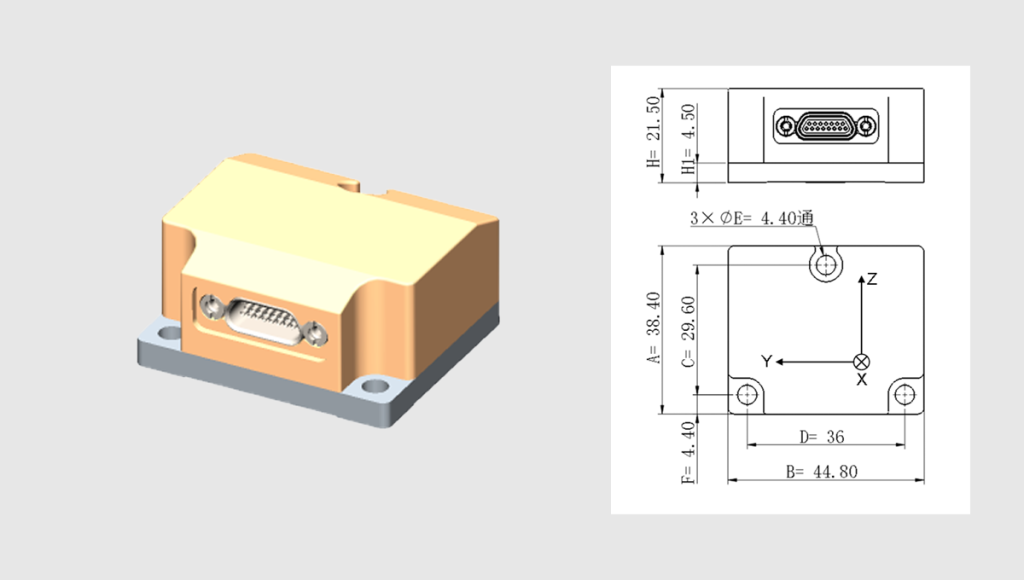KH-MEMS-NP10A MEMS IMU

Overview
TThe KH-MEMS-NP10A MEMS IMU consists of three single-axis MEMS gyroscopes, three single-axis MEMS accelerometers, and an integrated PCB circuitry for real-time data processing. It is capable of outputting real-time tri-axial angular velocity, tri-axial specific force, and temperature data. Prior to shipping, the unit undergoes rigorous full-temperature range compensation for both the gyroscopes and accelerometers.
Primary Performance
- Gyroscope
| Indicator | Value | Unit |
| Range | ±500 | °/s |
| Bias Stability (1σ, 1s, full temp) | 15 | °/h |
| Bias Stability (1σ, 1s, room temp) | 10 | °/h |
| Angular Random Walk | <0.15 | °/√h |
| Bias Repeatability (1σ, room temp) | <3 | °/h |
| Scale Factor Non-linearity | <300 | ppm |
| Resolution | <1 | °/h |
| Bandwidth (BW@3dB) | 100 | Hz |
| G-Sensitivity | <3 | °/h/g |
- Accelerometer
| Indicator | Value | Unit |
| Range | ±30 | g |
| Bias Stability (1σ, 1s, full temp) | 1 | mg |
| Bias Repeatability | 1 | mg |
| Scale Factor Non-linearity (1σ) | <500 | ppm |
| Bias Repeatability (1σ, room temp) | <3 | °/h |
| Scale Factor Non-linearity | <300 | ppm |
| Threshold/Resolution | 20 | ug |
| Bandwidth | 100 | Hz |
| Cross-Coupling Coefficient | 10 | ‘ |
System
| Indicator | Value | Unit |
| Update Rate | 200(default), 1000(max) | HZ |
| Supply Voltage | 5±0.5 | V |
| Boot Time | 1.5 | s |
| Operating Temperature Range | -45~+60 | ℃ |
| Storage Temperature Range | -55~105 | ℃ |
| Power Consumption | <2 | W |
| Weight | ~60 | g |
Electrical Interface
The IMU features a J30J-15ZKP connector for external interfacing and employs an RS-422 serial port for data output. The default baud rate is 230400 bps, with a maximum of 921600 bps. Pin Definitions: As shown in the table below.
- IMU Interface Difinitions
| Pin No. | Signal | Function |
| 1 | 422_T- | RS422 Output – |
| 2 | 422_R- | RS422 Input – |
| 3 | IO1 | IO |
| 4 | IO2 | IO |
| 5 | IO3 | IO |
| 6 | PULSE | 5ms TTL Pulse Output |
| 7 | IO4 | IO |
| 8 | VCCIN | Power Supply (+5V) |
| 9 | 422_T+ | RS422 Output + |
| 10 | 422_R+ | RS422 Input + |
| 11 | IO5 | IO |
| 12 | GND | GND |
| 13 | GND | GND |
| 14 | NC | No Connection |
| 15 | GND | Power Ground |
Communication Process and Protocol
Upon power-up, the IMU performs a self-test (self-test duration is no more than 1.5s). Once the self-test is completed, regardless of whether the self-test is successful, the IMU immediately sends a product information data frame with frame ID C0H via the serial port at a 5ms interval. This frame is transmitted for 5 seconds. Subsequently, it sends a measurement data frame with frame ID 01H at a 5ms interval (the IMU power-up self-test result and real-time self-test result are both indicated in this frame’s IMU status word). This measurement data frame is sent within 5ms after the pulse signal marking the IMU’s sampling moment is emitted.
The external communication interface of the IMU is RS-422 serial port. Communication parameters are: default baud rate of 230400bps, 1 start bit, 8 data bits, 1 stop bit, and no parity bit. Input and output data are in binary format.
In the data frame, multi-byte data sends the lower byte first.
The IMU communication data frame format is as shown in the table below.
- IMU Communication Date Frame Format
| Byte Number | Parameter Name | Byte Count | Data Type | Content |
| 1 | Frame Header | 1 | UINT8 | 5AH |
| 2 | Frame Header | 1 | UINT8 | A5H |
| 3~4 | Data Length(Bytes) | 2 | UINT16 | Measurement data frame is 36 bytes;Product information frame is 49 bytes |
| 5 | Frame ID | 1 | UINT8 | |
| 6~n-3 | Data | n-8 | Data content related to Frame ID (see table below) | |
| n-2 | Frame Number | 1 | UINT8 | 0~199 |
| n-1~n | Checkcode | 2 | UINT16 |
“Data Length” definition: The total number of bytes in the entire frame minus 4 (excluding the frame header and checkcode), i.e., n-4.
“Checkcode” definition: CRC-CCITT checkcode of all bytes from the data length byte (serial number 3) to the byte before the checkcode (a total of n-4 bytes). The CRC-CCITT checkcode is calculated using the following program (first and only once use the function buildTableCRC_CCITT() to construct the 16-bit CRC-CCITT direct query table, and then use the function calcCRC16 to calculate the CRC-CCITT checkcode each time).
// Note: The polynomial’s highest bit is always “1”, so the highest bit “1” is
// omitted.
// CRC-CCITT = X^16 + X^12 + X^5 + X^0
const UINT16 polyCRC_CCITT = 0x1021;
UINT16 tableCRC16[256]; // 16-bit CRC direct query table
// Construct a 16-bit CRC-CCITT direct lookup table
void buildTableCRC_CCITT()
{
buildTableCRC16(polyCRC_CCITT);
}
// Construct a 16-bit CRC direct lookup table
void buildTableCRC16(UINT16 poly)
{
UINT16 i16, j16;
UINT16 data16;
UINT16 accum16;
for (i16 = 0; i16 < 256; i16++)
{
data16 = (UINT16)(i16 << 8);
accum16 = 0;
for (j16 = 0; j16 < 8; j16++)
{
if ((data16 ^ accum16) & 0x8000)
{
// poly can use polyCRC_CCITT or other 16-bit generating
// polynomials
accum16 = (accum16 << 1) ^ poly;
}
else
{
accum16 <<= 1;
}
data16 <<= 1;
}
tableCRC16[i16] = accum16;
}
}
// Calculate the 16-bit CRC-CCITT checkcode for cnt bytes using the lookup
// method
UINT16 calcCRC16(UINT8 *bytes, int cnt)
{
int i;
UINT16 crc16;
crc16 = 0; // Preset initial value
for (i = 0; i < cnt; i++)
{
crc16 = (crc16 << 8) ^ tableCRC16[(crc16 >> 8) ^ *bytes++];
}
return crc16;
}
- IMU Product Information Date Frame
Length: 53B, Period: 5ms
| Byte Number | Content | Data Length (Bytes), Type | Remarks |
| 1 | Frame Header | 1, UINT8 | 5AH |
| 2 | Frame Header | 1, UINT8 | A5H |
| 3~4 | Data Length | 2, UINT16 | 0031H/49 |
| 5 | Frame ID | 1, UINT8 | C0H |
| 6~50 | Product Status Info | 45, INT8 | Should include manufacturer, product model, product number, batch, phase, status, software version, etc. Represented as an English string ending with 00H. Fill in excess with 00H. |
| 51 | Frame Number | 1, UINT8 | 0~199 |
| 52~53 | Checkcode | 2, UINT16 |
- IMU Measurement Data Frame
Length: 40B, Period: 5ms
| Byte Number | Content | Range(Unit) | Data Length (Bytes), Type | LSB/Equivalent | Remarks |
| 1 | Frame Header | 1, UINT8 | 5AH | ||
| 2 | Frame Header | 1, UINT8 | A5H | ||
| 3~4 | Data Length | 2, UINT16 | 0024H/36 | ||
| 5 | Frame ID | 1, UINT8 | 01H | ||
| 6~9 | x-axis acceleration | -2147~2147(m/s2) | 4, INT32 | 0.000001 | |
| 10~13 | y-axis acceleration | -2147~2147(m/s2) | 4, INT32 | 0.000001 | |
| 14~17 | z-axis acceleration | -2147~2147(m/s2) | 4, INT32 | 0.000001 | |
| 18~21 | x-axis angular velocity | -2147~2147(deg/s) | 4, INT32 | 0.000001 | |
| 22~25 | y-axis angular velocity | -2147~2147(deg/s) | 4, INT32 | 0.000001 | |
| 26~29 | z-axis angular velocity | -2147~2147(deg/s) | 4, INT32 | 0.000001 | |
| 30 | x-axis accelerometer temperature | -128~127(℃) | 1, INT8 | ||
| 31 | y-axis accelerometer temperature | -128~127(℃) | 1, INT8 | ||
| 32 | z-axis accelerometer temperature | -128~127(℃) | 1, INT8 | ||
| 33 | x-axis gyroscope temperature | -128~127(℃) | 1, INT8 | ||
| 34 | y-axis gyroscope temperature | -128~127(℃) | 1, INT8 | ||
| 35 | z-axis gyroscope temperature | -128~127(℃) | 1, INT8 | ||
| 36~37 | IMU Status Word | 2, UINT16 | See Table 5.4 | ||
| 38 | Frame Number | 0~199 | 1, INT8 | ||
| 39~40 | Checkcode | 2, UINT16 |
- IMU Status Word Definition
| Bit | Description | Definition | Remarks |
| b0 | Fault Bit | 1: Fault, 0: OK | |
| b1 | Severity Level 4 Fault | 1: Fault, 0: OK | |
| b2 | Severity Level 3 Fault | 1: Fault, 0: OK | |
| b3 | Severity Level 1 & 2 Fault (Level 1 is most severe) | 1: Fault, 0: OK | |
| b4~b15 | IMU Device Faults (Manufacturer-defined) |
